
JAMES R. ARNOLD
TET OFFENSIVE 1968. TURNING POINT IN VIETNAM
The Communist plan sent 35 battalions against six primary targets in the Saigon area. Their objectives were the headquarters of the South Vietnamese Joint General Staff (JGS); the Independence Palace, which served as President Thieu's office; the American Embassy; Tan Son Nhut Air Base; the Vietnamese Navy headquarters; and the National Broadcasting Station. Eleven battalions, comprising about 4,000 mostly local men and women, assaulted the city's urban centre. The C- 10 Saigon Sapper Battalion, numbering about 250 men and women who were very familiar with Saigon - many worked as cyclopousse or taxicab drivers - spearheaded the attacks. They were to hold the objectives until additional local force battalions arrived to reinforce them.
Shortly before 3am, the guard outside the government radio station saw a small convoy stop and disgorge a group of armed men dressed in South Vietnamese Riot Police uniforms. An officer briskly approached him and announced the rein-forcements had arrived. The guard responded: 'I haven't heard anything about it.' Then the officer shot him.
Years earlier, Viet Cong agents had purchased a house 200 yards from the radio station. There they had stockpiled arms and ammunition for future operations. When the soldiers, assigned to attack the radio station broke out the stored weapons they found termites had eaten through the wooden gun-stocks. Undeterred, they improvised by wrapping rags around the weapons and proceeded with the mission. The well-organized attackers broke into the station while a machine- gunner provided covering fire from a nearby apartment building. His accurate first sweep killed most of the platoon of ARVN paratroopers who lay sleeping on the roof. A North Vietnamese radio specialist followed the assault wave into the station. His job was to play a pre-recorded tape of Ho Chi Minh announcing the liberation of Saigon and the beginning of the General Uprising. He had detailed diagrams of the station layout and duplicate keys provided bv an agent on the station's staff.

A wounded VC fighter and a female nurse captured by ARVN rangers in Saigon during the 'Mini-Tet' attacks in the summer of 1968. Similar civilian-clad local VC spearheaded the attacks at Tet.
The foresight of the ARVN lieutenant colonel in charge of the station thwarted these plans. The previous afternoon this officer had arranged to take the station off the air if an attack came. Upon hearing gunshots, a technician sent the coded signal and power to the station was cut off. The attackers held their objective for six hours, but were unable to broadcast Ho's message.
The 34 sappers assigned the Independence Palace employed the same commando-style tactics as would be used against the American Embassy. At 1.30am a B-40 rocket exploded on the staff entrance gate. The sappers rushed toward the objective. However, the Palace was one of the best defended sites in all of South Vietnam. The Palace security force, comprising the presidential guard, national and military police and two tanks, were far too strong for the attackers. Repulsed, they retreated into a nearby building. Such was their discipline that they held out for two days in a futile last-ditch stand. Thirty-two died during this operation.
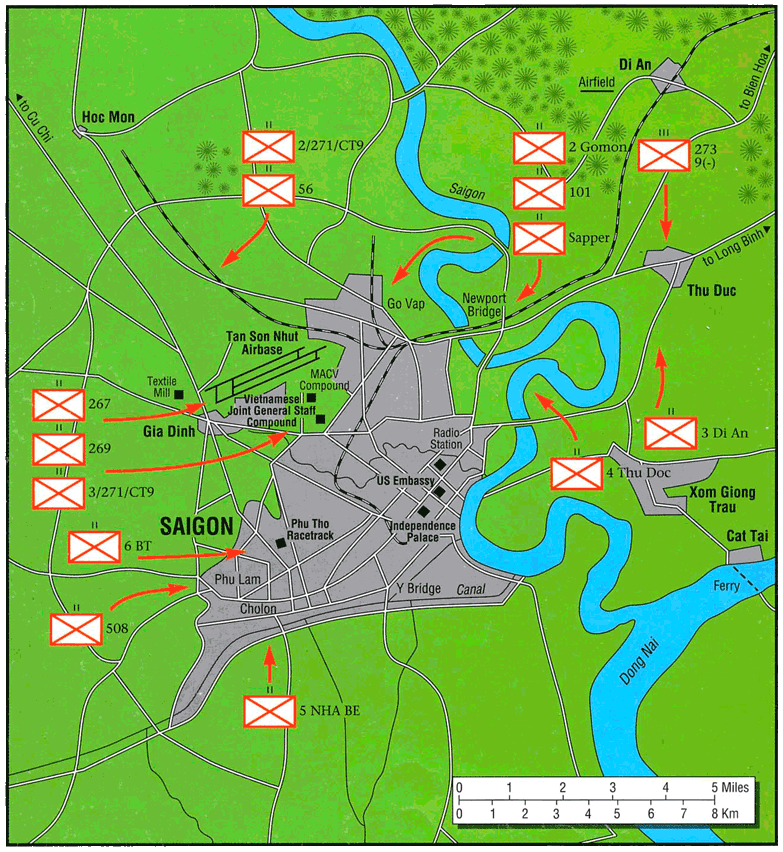
The Assault on Saigon
Against Navy headquarters the Communist high command had devised a complicated plan intended to capture both headquarters and nearby docked ships. The ships would then be used to transport people from rural areas to Saigon to participate in the General Uprising. In pursuit of this ambitious scheme, twelve sappers blew a hole in the security wall but were unable to make more than a brief penetration. Within five minutes, ten were dead. Here, as often the case nationwide, the attackers had been told to seize the objective and hold until reinforcements arrived. Also, as frequently proved the case, the reinforcements did not exist.
The attack against the JGS compound began at 2.00am. Just as the sappers began their assault on Gate Number 5, an American Military Police patrol jeep appeared. The attackers engaged the jeep, and this pause allowed the ARVN guard to close the gate and prepare a defence. Additional American MPs assisted the defenders and the first assault collapsed. The Communists intended a local force unit, the 2nd (Go Mon) Battalion, to attack Gate Number 4 at the same time, but the assault units were delayed during the approach march. They were not in position until 7.00am. Amazingly, against a thoroughly alert defence they managed to penetrate the JGS compound. But these attackers made the same mistake committed by the sappers who assaulted the American Embassy. Instead of capitalizing on their success - which in this case meant overrunning the virtually undefended nerve centre of the entire South Vietnamese military - they dug in and awaited reinforcements. As prisoners later revealed, the attackers blindly adhered to the pre-battle plan and thought they had accomplished their mission when they seized a building clearly marked 'General Headquarters'. In fact, this building was only one of several command buildings, and not the most important.

ARVN soldiers of the 30th Ranger Battalion tight in Saigon on 31 January.
The failure of initiative allowed an American helicopter to deliver President Thieu to the compound at about noon. Thieu used the command facility as an emergency headquarters. He bravely conducted meetings even while fighting raged about half a mile away. Eventually ARVN airborne and marine units rooted the Go Mon battalion out of the JGS compound. The attackers had come very close to achieving a striking success.
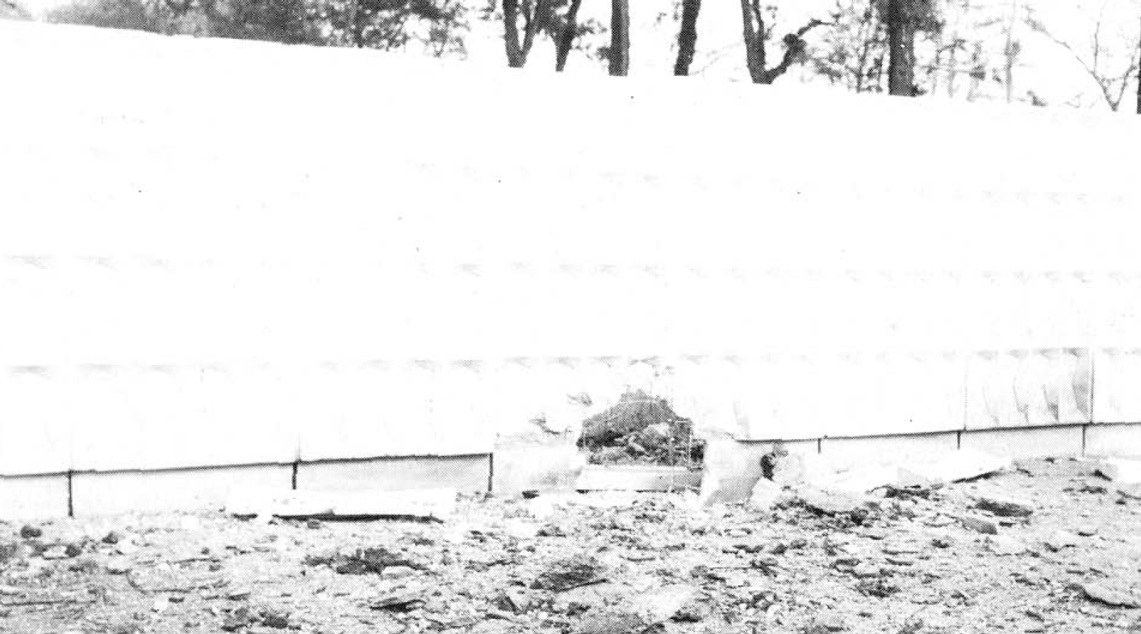
The hole in the embassy wall through which 19 VC entered the compound.
The South Vietnamese had always been sensitive about an American presence in the cities. Bowing to these sensitivities, as a gesture of confidence in ARVN competence, and because of a belief that the Communist threat had diminished, in mid-December the US Command had yielded to the ARVN full responsibility for the close-in defence of Saigon. Thus, only the 1,000-man strong 716th US Army Military Police Battalion (MP) guarded more than 130 American installations in the greater Saigon area. In spite of the alert, only some one-third were at their posts when the VC struck. A mere 25 of the 300 Vietnamese MPs were on hand to assist them.
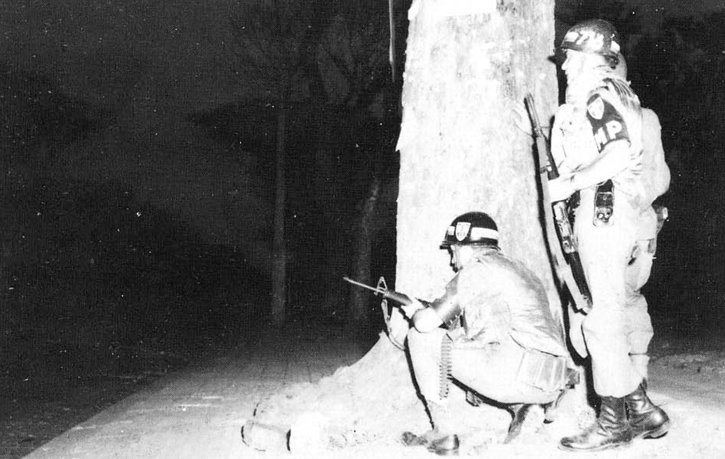
Soldiers of the 716th Military Police Battalion across the street from the still-occupied American Embassy.
The 716th MP Battalion's Message Log for the first two hours of the offensive described the widespread, surprise VC attacks:
0300: BOQ No. 3 reports enemy action
0315: US Embassy under attack
0316: Explosion at Phoenix City BOQ
0317: Explosion at Townhouse BOQ
0318: BOQ No. 1 under attack
0319: McArthur BOQ under attack
0321: Report of hostile attack at Rex BOQ
0325: Explosion at BOQ No. 2
0340: Automatic-weapons fire and attack at BOQ No. 3
0341: MPs at US Embassy request urgent ammo re supply
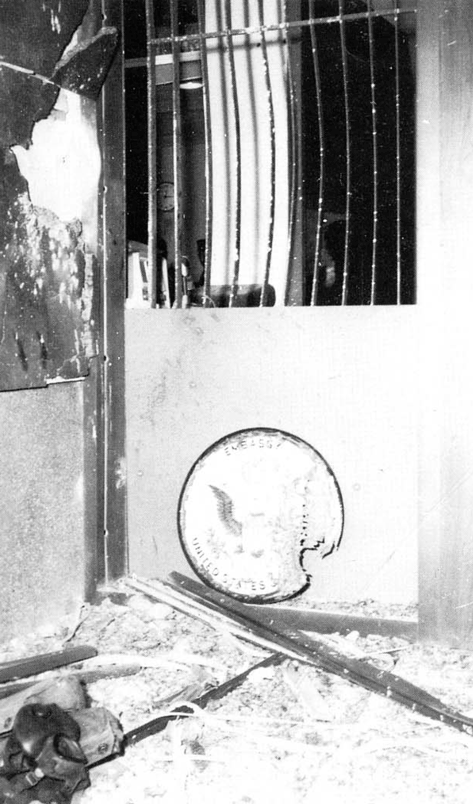
The damaged side entrance to the embassy
and the symbol of tattered American prestige.
0342: Heavy sniper fire at Metropole BEQ
0350: Incoming mortars at Montana BEQ
0358: Saigon port area reports small-arms and automatic-weapons fire
0359: Mortars and rockets fired at US Embassy; reinforcements requested
0407: MP jeep C9A reports that 2-ton truck earning 25-man reaction team to BOQ No.3 hit by rockets and claymore mines. Heavy casualties
0408: Jeep C9A hit; both MPs killed
0419: BOQ No. 3 pleads for ammo resupply
0420: General Westmoreland calls; orders first priority effort to recapture US Embassy
0430: Request armored vehicles and helicopters for embassy assault
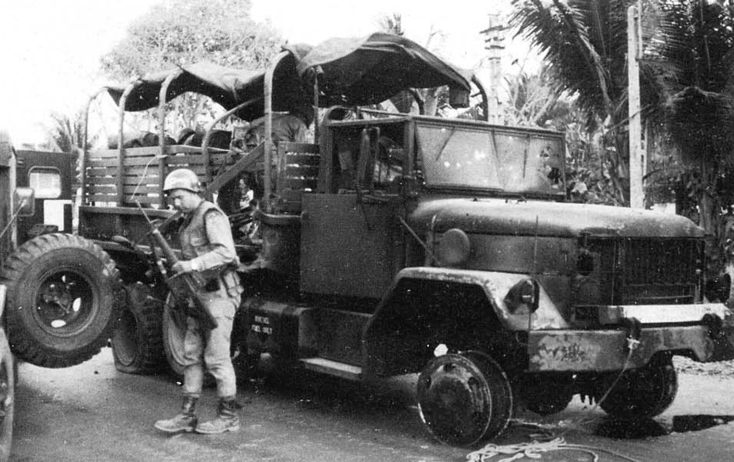
Combat sequence at Bachelor Officer Quarters No. 3. During the night the first reinforcements arrived via truck, hit a claymore mine and suffered heavy losses.
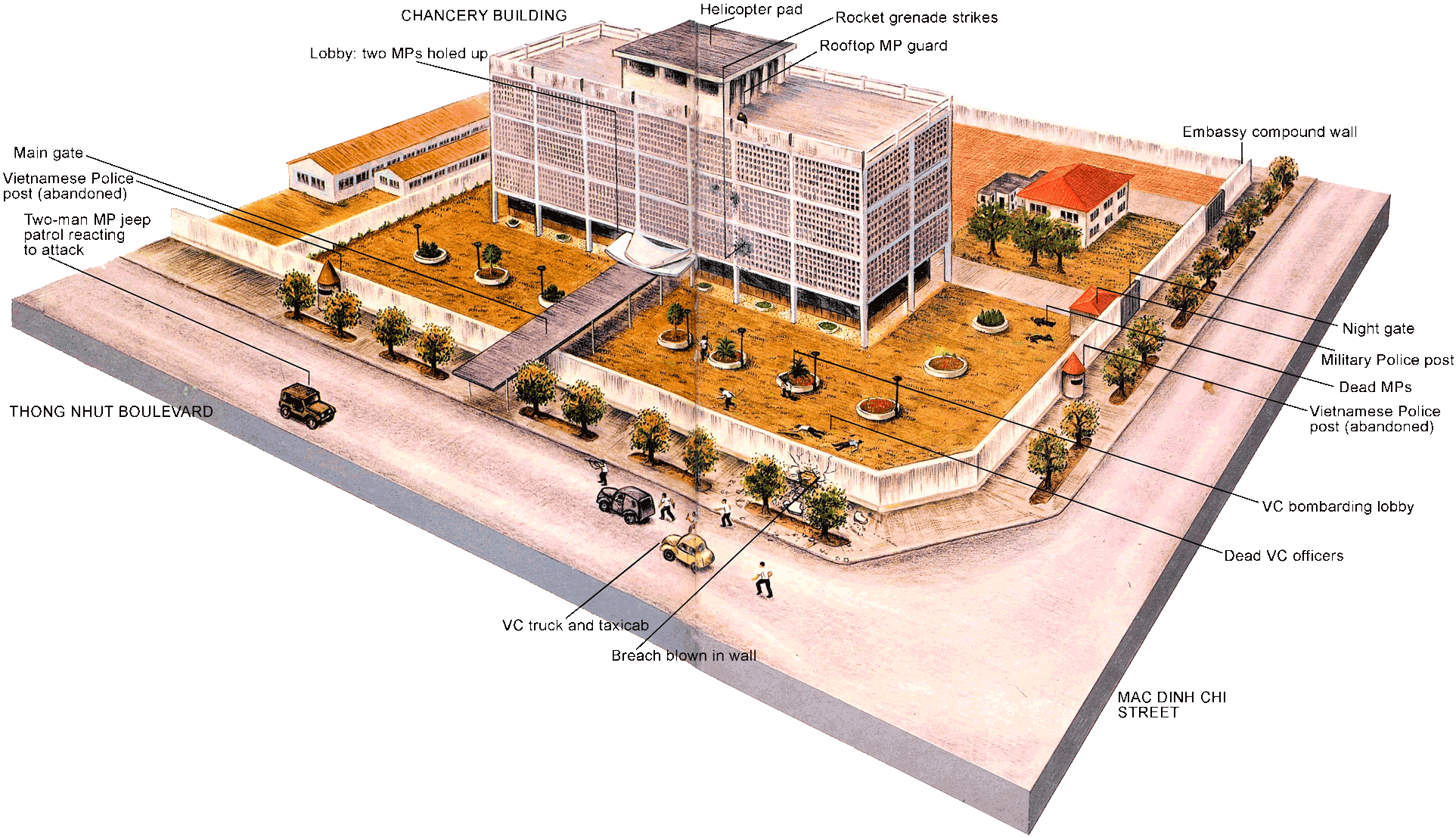
EMBASSY ATTACK, SAIGON
2.47am 31 January 1968. Viet Cong guerrillas launch an assault on the United States Embassy Compound.
At a rundown automobile repair shop five blocks from the American Embassy, 19 sappers belonging to the C-10 Battalion boarded a small Peugeot truck and a taxi-cab to begin the short drive to their objective. A South Vietnamese policeman spotted the vehicles moving without lights. He chose to avoid trouble and so did nothing. The vehicles turned onto Thong Nhut Boulevard where they encountered the embassy's outer layer of protection provided by four more South Viet namese police. They too fled without firing a weapon. The vehicles proceeded along the second line of defence, an eight-foot high wall that surrounded the embassy compound. Approaching the night gate, they encountered two American MPs. Although attacks had been taking place throughout Saigon for more than an hour, such was the state of interallied communication that the embassy defenders had no idea the Communists had broken the truce. Amid an exchange of gunfire, the MPs backed into the compound and shut the steel gate, thus sealing the embassy from the outside world. At 2.47am a guard radioed the signal that the embassy was under attack.
Meanwhile, out in the street, the attackers unloaded weapons and explosives. One VC used a satchel charge to blow a three-foot hole in the wall. Displaying formidable courage but poor tactics, both VC officers led the way through the breach. The explosion had alerted the two guards. They whirled around and shot down the officers. One shouted into his radio: 'They're coming in! They're coming in! Help me! Help me!' It was his last message. With their burst of accurate fire the two MPs had eliminated the enemy leadership; but they too soon died in the return fire.
A two-man MP jeep patrol responded to the alert and rushed towards the embassy. They also died in a hail of fire from the Viet Cong who remained outside the wall. Meanwhile two more guards within the embassy itself locked the building's heavy teak doors. Seconds later a rocket grenade smashed through the granite slab on which hung the United States Seal. Its explosion badly wounded one guard. Two more rockets exploded in the lobby followed by a fragmentation grenade. Aimed with a.38 pistol, 12-gauge shotgun, and a sub-machine-gun, the remaining guard resolved to sell himself dearly as he awaited the final VC rush. The only other guard in the embassy tried to help. From atop the embassy roof he aimed his shotgun at the attackers in the courtyard. It jammed, leaving the VC free to range within the compound.
However, the loss of leadership now cost the guerrillas their opportunity to exploit their initial success. They had an ample supply of C-4 explosives to breach the embassy itself. Only a handful of lightly armed Americans remained in the building. Instead, the VC milled about in confusion and eventually took position behind the shelter of some convenient oversized flower tubs. From this position they exchanged gunfire with targets of opportunity. Outside the walls American reinforcements began to arrive. VC fire kept them from entering via the gate. In the dark they failed to sec the hole in the wall. For the rest of the night it was a standoff.

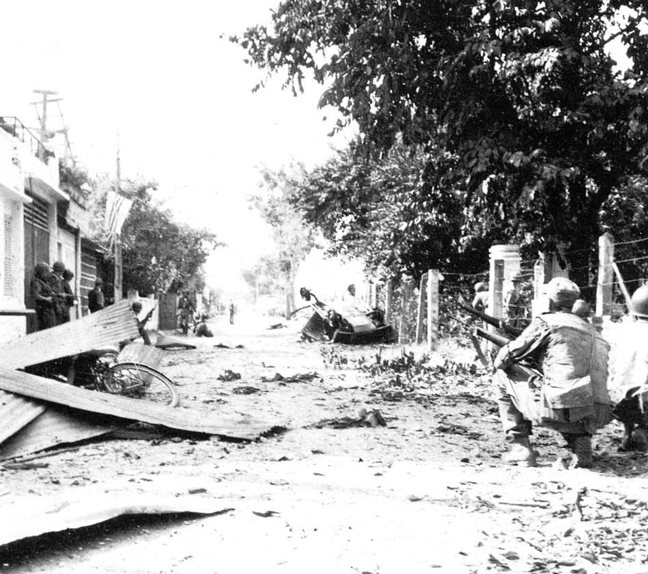
Reserves, following an ARVNV-100 armoured car, tried to work up the alley to rescue the wounded at the truck. Heavy fire drove off the armoured car.
More South Vietnamese and US reinforcements arrived to resume the advance.
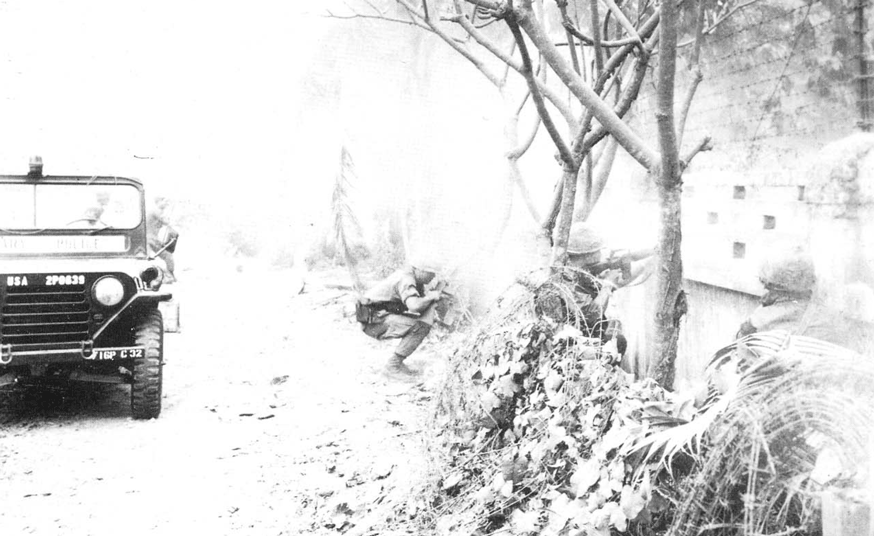
MPs pinned down by heavy VC fire.
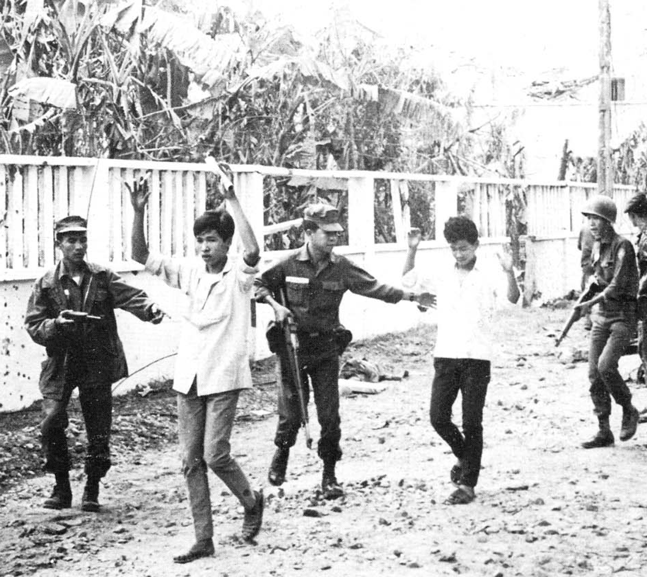
Resistance finally crumbled and VC suspects were removed.


0449: Cleveland and Columbia BOQ request ammo and assistance
0550: Three claymores detonated at Saigon motor pool.
Booby traps discovered.'
Shortly after the first alert, the commander of the 716th implemented the 'disaster plan'. Designed for such emergencies as riots or isolated bombings, it was woefully inappropriate for the chaos of combat sweeping through Saigon. Jeeps and open-topped trucks, such as those mentioned in the 0407 and 0408 entries above, rushed to respond to the dozens of emergencies. Their bravery mattered less than their lack of firepower and training. By dawn the VC had made major penetrations into western and southern Saigon and controlled large areas in the suburb of Cholon.
The widespread attacks such as those described in the 716th's Message Log typically featured a handful of attackers. However, initial reports could not assess the size of the enemy forces. To the American officer commanding the Saigon area, General Weyand, it was difficult to make sense of the multiple enemy thrusts. The fact his own headquarters was under rocket and ground attack also hampered tactical judgment. The map showing the reported attacks around Saigon reminded him of 'a pinball machine, one light after another going on as it was hit'. Between 3am and 5am he shifted some 5,000 mechanized and airborne troops to defend the various installations under assault. His rapid, yet considered reactions limited enemy success.

The Bien Hoa - Long Binh Area
Allied casualties from the fighting. Sixteen MPs died and 21 were wounded in the fighting around BOQ No. 3.
Soldiers of the 2/47th Battalion (mechanized) assault I C positions in the Long Binh area.
Fifteen miles north of Saigon was the Long Binh logistical and command complex. This sprawling base area, which extended to the enormous Bien Hoa Air Base, was a target too big to overlook by Communist planners. At 3.00am an intense rocket and mortar barrage pelted the area. The veteran 275th VC Regiment assaulted Long Binh's northern perimeter while a local VC battalion launched a diversionary attack against the eastern bunker line. Meanwhile VC sappers infiltrated the huge ammunition dump just north of Long Binh. Simultaneously, the 274th VC Regiment attacked Bien Hoa.
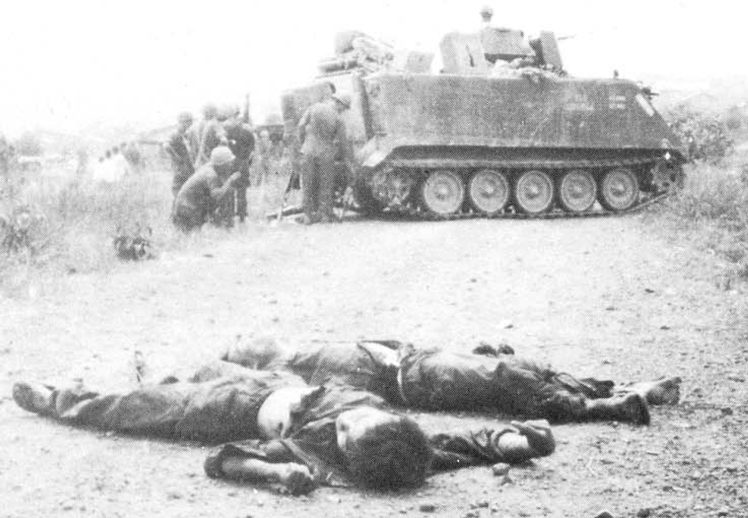
Some of the VC killed by the APCs of the 9th Infantry Division.
While well-coordinated and bravely driven home, these attacks fell victim to superb American mobility and firepower. Half an hour after the opening barrage, the 2/47th Battalion (mechanized) began a speed march from Bear Cat toward Long Binh. At first light the 2nd Battalion/560th Infantry airlifted into Bien Hoa Air Base. The élite 11th Armored Cavalry Regiment, the Blackhorse Regiment, made a twelve-hour forced march to arrive at Long Binh during the day. Once in position, the multiple machine-guns of the mechanized units' APCs shot apart all Vict Cong- attacks. Perhaps above them all was the performance of the mechanized cavalry troop of the 9th Infantry Division.
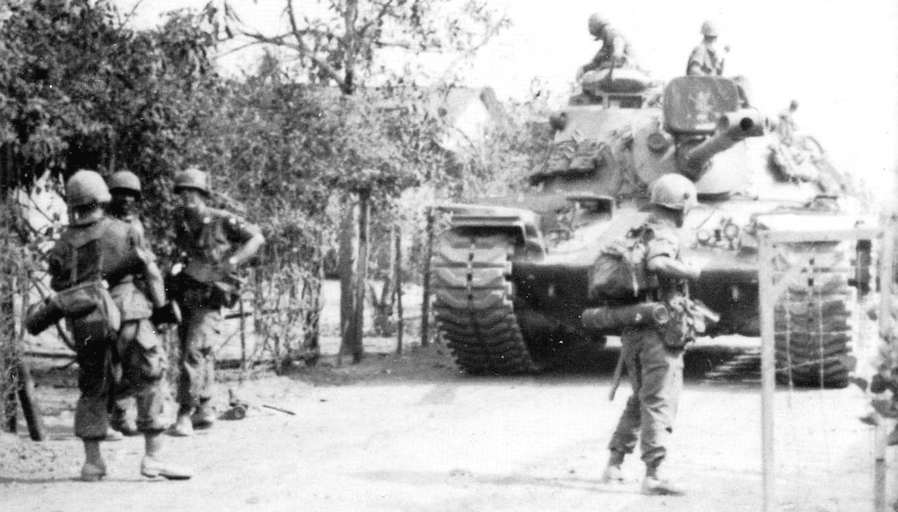
At bases north-east of Saigon, the radio net of 1/5 Armored Cavalry, 9th Infantry Division, came alive at 6am on 31 January. The squadron learned that large enemy forces were attacking Tan Son Nhut, Bien Hoa, Long Binh, and Saigon itself. Officers paid particular attention to news from Long Binh, where one of the Division's mechanized battalions had been sent the night before. By listening to that battalion's tactical radios, the squadron anticipated that soon it would be needed. One hour later came the order for Troop A to move out.
Amid great confusion, the squadron commander ordered the troop, minus one-third of its strength left behind to garrison a fire-support base, to begin a speed march to Bien Hoa. Hardly had the troop left its base than it ran into an ambush. The VC had skilfully anticipated American reactions, but they underestimated the cavalry's mobility and firepower. The troop drove through the ambush while laying down a carpet of lire from their ACAVs. Without suffering serious damage, Troop A cleared the fire zone only to encounter a mile-long strip of houses each one of which seemed to conceal an enemy gunner. Beginning to take losses, the troop managed to speed through the gauntlet.
The column's lead tank came to a small concrete bridge and rolled across it without incident. Suddenly an explosion rocked the air and the bridge collapsed in fragments. The troop's ACAVs managed to ford the stream, but the balance of the heavier tanks had to remain behind. Troop A entered the city of Bien Hoa where it found the central square crowded with people. It pushed through the throng, but suddenly the troopers realized that the 'crowd' was actually several companies of enemy soldiers. The enemy simultaneously realized that they confronted American armour. The Viet Cong's initial volleys disabled two ACAVs. More ACAVs entered the square and opened fire with all their weapons. They drove the VC to cover, pushed the knocked- out vehicles aside, rescued their crews, and pressed on for the airbase. The column now comprised one tank and eight ACAVs.
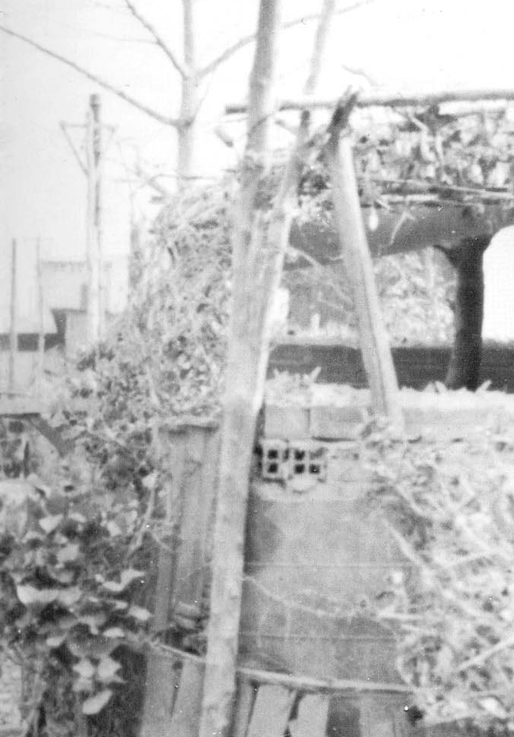
Descended from Second World War tanks, the M-48 medium tank served as the mainstay of the American armour during the Vietnam War. A crew of four, comprising a commander, gunner, loader and driver manned the tank. Its armament consisted of a 90mm gun, a 7.62mm machine-gun by the commander's cupola, and a.50cal machine-gun by the loader's cupola. With a top speed of 30mph, it had surprising 'jungle busting' cross-country ability. Although heavily armoured, tanks sacrificed their mobility and thus proved vulnerable in urban combat. A Patton belonging to the 11th Armored Cavalry supports operations on 2 February around Bien Hoa.
The reassuring words of the squadron commander filled the radio. From an overhead helicopter he directed the cavalry through the byzantine labryinth of narrow streets. Nearing the air base he spotted hundreds of enemy soldiers belonging to the 274th VC Regiment lining Highway 1, apparently deployed to stop any relieving column. His warning saved the column. Exploiting its mobility, the cavalry left the highway and drove a parallel route. The ACAVs' machine- guns shot up the unsuspecting enemy from the rear and finally reached the beleaguered air base.
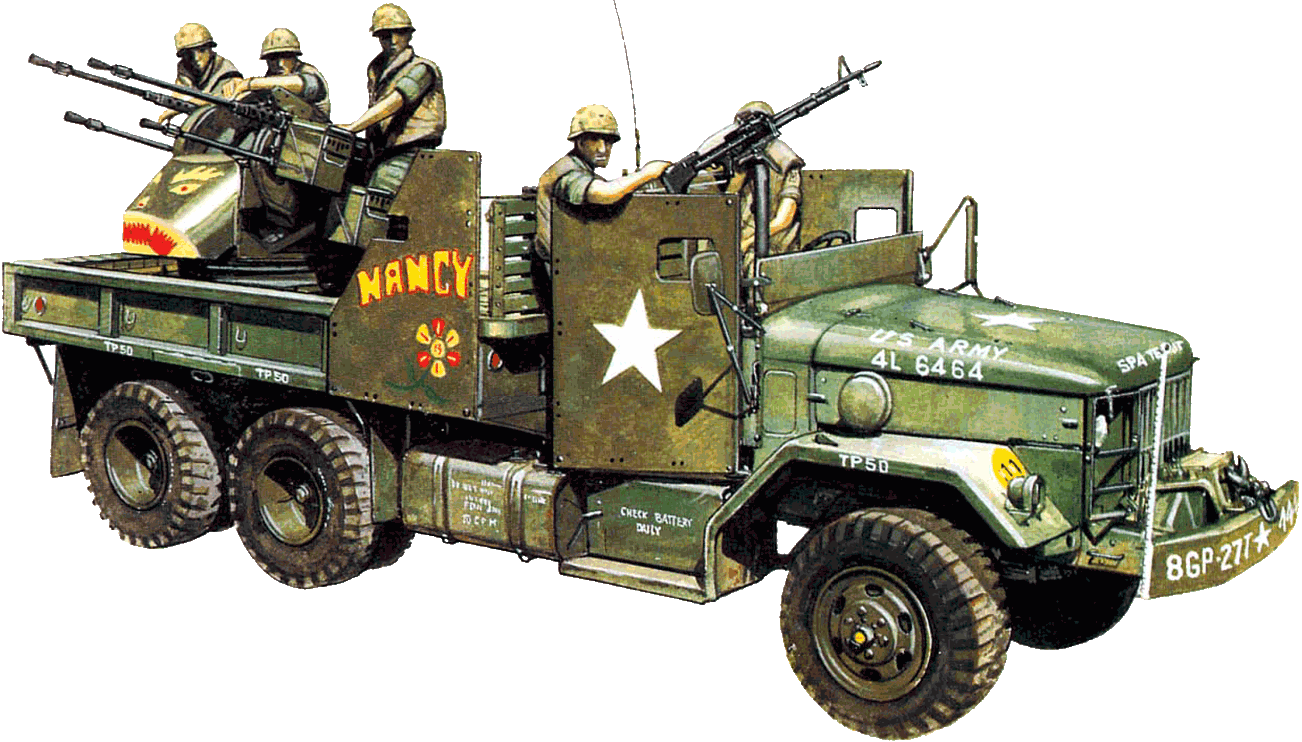
M35A2 'gun truck' of 27th Transportation Battalion. Illustration by Peter Sarson and Tony Bryan.
Its presence at Bien Hoa provided the narrow margin between victory and defeat. Along with the 2nd Battalion/506th Infantry, it repulsed all assaults. By day's end its one tank had been hit nineteen times and the crew replaced twice. Of the twelve ACAVs that began the mission, only six still ran by nightfall. The troop had suffered heavily, but the survivors felt elation that after months of being the target of ambushes without being able to hit back, it had finally met a stand-up enemy and inflicted terrible losses upon him.
A cavalry officer describes his unit's feelings on the first day of February:
'I can still remember the feeling of pride we had in our operations center the next morning when we heard the squadron commander's initial report... that Saigon, Bien Hoa, and Long Binh were literally ringed in steel... Five cavalry squadrons had moved through the previous day and night, converging on the Saigon area. When dawn broke, they formed an almost-continuous chain of more than five hundred fighting vehicles... We actually cheered... from that morning the outcome was never in doubt. We knew that our enemy could never match our mobility, flexibility, and firepower.'
We have much more interesting information on this site.
Click MENU to check it out!
∎ cartalana.com© 2009-2025 ∎ mailto: cartalana@cartalana.com